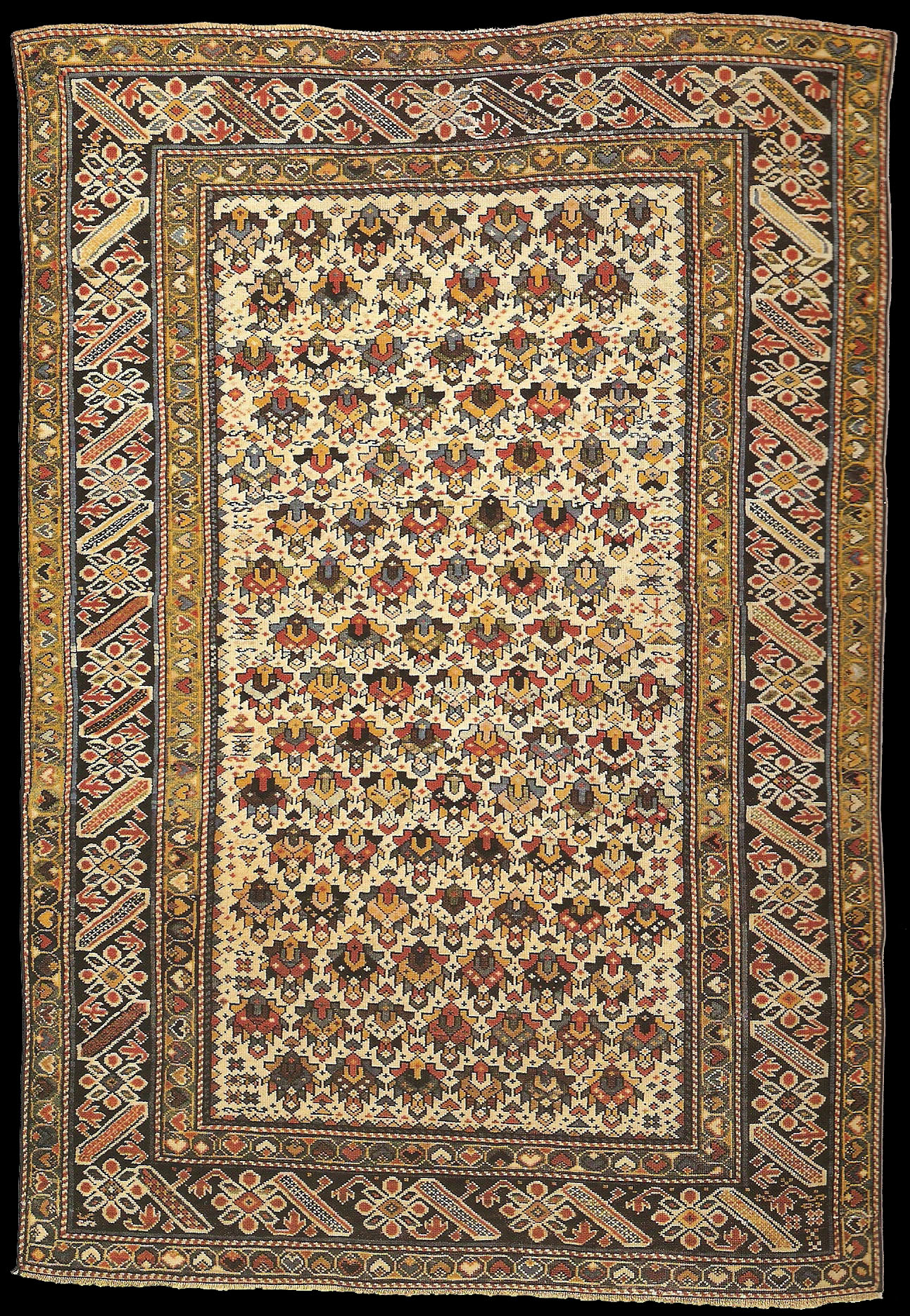
27 Kuba Chi-Chi rug,
Northeastern Caucasus, second half of the 19th century, wool pile on wool
foundation, 170 x 115 cm, (published at Alberto Boralevi "Splendori di Citta, Tesori Di Villaggio, Antichi Tappeti
Dalla Persia E Dal Caucaso", La Torre, Tappeti Orientali)
This
second Chi-Chi can be immediately recognized as such because of its typical
border of rosettes and diagonal bars accompanied by a double frame of
heart-shaped leaves. The field, however, is rather unusual for this typology
even though it does reflect the general character of a composition of small
ornaments arranged in parallel, staggered rows. The motif that comprises the
pattern of the field is a sort of polychrome bud, similar to what we
frequently find on white background carpets and prayer rugs from Daghestan,
as well as in others from Kuba, mainly in the Seikhurs. The use of motifs of
different origins - but all from the same general geographic area
(Northeastern Caucasus) in the same rug should be no surprise. We must not
forget that although the weavers of the Caucasian villages knotted their
rugs according to their own traditions and distant tribal customs, they did
have to satisfy their customers. Nineteenth century Caucasian rug making is
a typical example of cottage industry. The ''manufacturers" worked at home
and were partly controlled - or managed - by the merchants who traveled from
village to village ordering the items and types they knew would sell best.
Therefore, it is possible that a rug with a white background and typical
Daghestan patterns could have been ordered from a weaver in a Chi-Chi
village. In addition to the border pattern, this rug also has other
unequivocally Chi-Chi features such as the shade of green in the smaller
frames and the wealth of secondary ornaments in the field that fill up every
bit of empty space with "S" shapes, small crosses, triangles, stars,
diamonds, etc. These ornaments are also used in the few empty spaces on the
border which, among motifs, includes a curious little stylized animal.
It is
because of all these features that this rug should be considered quite rare
and attractive for even the most demanding collector.
27 Kuba
Chi-Chi, Caucaso Nord Orientate, Seconda meta del XIX secolo, Vello in lana
su armatura in lana, 170 x 115 cm.
Questo
secondo esemplare di Chi-Chi e immediatamente riconoscibile come tale per la
tipiea bordura a rosette e barre diagonali, accompagnata da una doppia
cornice di foglioline a cuore. Tl campo invece e abbastanza insolito per
questa tipologia, anche se rispecchia il carattere generale di una
composizione di piccoli ornamenti disposti in file parallele e sfalsate.
II motivo
che costituisce il pattern del campo e una sorta di bocciolo policromo, del
tipo che si trova abbastanza frequentcmente nei tappeti e nelle preghiere a
fondo bianco del Daghc-stan, ma e riscontrabile anehe in altri esemplari
dell'area di Kuba, soprattutto del gruppo dei Seikhur. Non deve stupire la
compresenza di motivi di diversa origine, ma tutti della stessa area
geografica (il Caucaso Nord Orientale) nello stesso tappeto. Non bisogna
dimenticare che le tessitrici dei villaggi del Caucaso annodavano si i loro
tappeti seguendo la propria tradizione e richiamandosi alle lontane origini
tribali, ma dovevano anche rispondere alle richieste della committenza.
L'industria del tappeto caucasico nell'Ottocento e un tipico esempio di
quella che gli Inglesi defmiscono Cottage Industry, in altre parole una
forma di manifattura a domicilio, parzialmente controllata dai mcrcanti e
dai raccoglitori, che viag-giavano di villaggio in villaggio commissionando
i pezzi e lc tipologie a loro piu gradite. E' quindi possibile che un
tappeto a fondo bianco, con i motivi tipici del Daghestan, sia stato
commissionato per qualche ragione ad una tessitrice di un villaggio ChiChi.
Oltrc al
disegno della bordura, il tappeto presenta anche altre caratteristiche
inequivocabilmente Chi-Chi, come la particolare tonalita di verde delle
cornici minori e la ricchezza di ornamenti secondari nel campo, a riempire
ogni minimo spazio vuoto, con forme a “S”, piccole croci, triangoli. stelle,
losanghe, ecc. Si noti a tale proposito come questi ornamenti secondari
vadano ad inserirsi anche nei pochi spazi vuoti della bordura, dove, tra
l'alrro, e raffigurato in un angolo un curioso animaletto stilizzato. Per
tutte queste caratteristiche I'esemplare e da considerarsi particolarmente
raro e attraente anche per il piu esigente dei collezionisti. |

